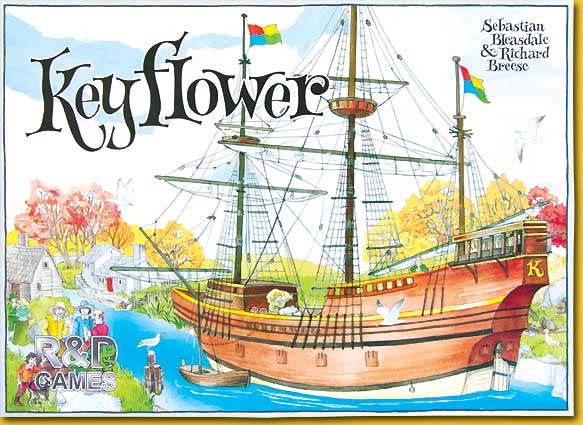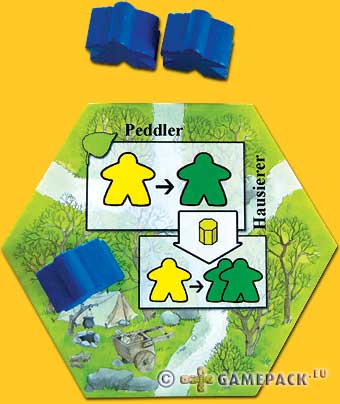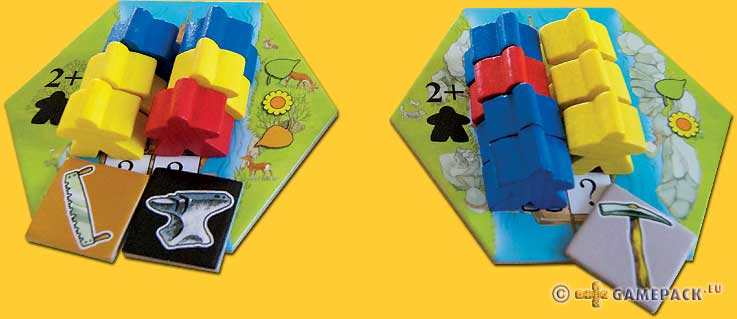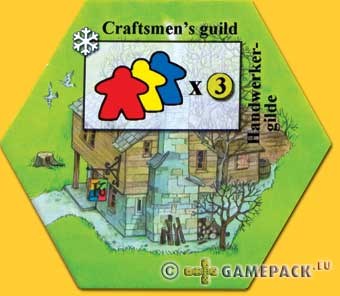Keyflower
Authors: Sebastian Bleasdale & Richard Breese
Publisher: R&D Games / Huch & Friends
Year: 2012
review by

| x |
|
|
|
|
|
|
|
|
|
|
|
|
|
|
|
|
|
|
|
|
|
x |
|
|
|
|
|
|
|
|
|
|
|
|
|
|
|
|
|
|
|
|
|
|
|
|
|
|
|
|
|
|
|
|
|
|
|
|
|
|
 |
|
'Keyflower' is the latest game in the ‘Key series’, with the previous game in the series being 'Key Market' from 2010. We don’t get a lot of back story: we build our own village, welcome new workers who join us by boat and thus we compete in the ongoing battle for the most victory points.
|
|
|
|
|
|
|
|
|
|
|
|
|
|
|
|
|
|
|
| x |
|
|
|
|
|
|
|
|
|
|
|
|
|
|
|
|
|
|
|
|
|
|
|
|
|
|
|
|
|
|
|
|
|
|
|
|
|
|
|
|
|
|
|
|
|
|
|
|
|
|
|
|
|
|
|
|
|
|
|
|
|
'Keyflower' is played over four seasons, starting in spring and ending in winter. The players each start the game with a -nearly identical- home tile and eight workers in a randomly drawn mix of yellow, red and blue. That’s already the first thing to take into account: nobody has their own color! There are also green workers but those are rarer and can primarily be acquired through the use of certain tiles.
|
|
|
|
|
|
|
|
|
|
|
|
|
|
|
|
|
|
|
| x |
|
|
|
|
|
|
|
|
|
|
|
|
|
|
|
|
|
|
|
|
|
|
|
|
|
|
|
|
|
|
|
|
|
|
|
|
|
|
|
|
|
|
|
|
|
|
|
|
|
|
|
|
|
|
|
|
|
|
|
|
 |
|
| x |
|
|
|
|
|
|
|
|
|
|
|
|
|
|
|
|
|
|
|
|
|
|
|
|
|
|
|
|
|
|
|
|
|
|
|
|
|
|
|
|
|
|
|
|
|
|
|
|
|
|
|
|
|
|
|
|
|
|
|
|
| Generally every season proceeds in the same manner: a number of village tiles are put in the center of the table and the available boats (as many as the number of players) are filled with additional workers and so-called ‘skill tokens’. Then the players take turns performing one action each time. In essence the choice can be reduced to one of three actions: bidding for a tile, using a tile, or passing. When bidding for a tile the player places one or more workers of one color on his side of the tile concerned. In addition to the village tiles the players can also bid for turn order tiles: these determine the order in which they can choose of the available boats at the end of the season. In order to use a tile the workers have to be placed onto the tile. The first use in a season requires one worker and each next use requires one more (a tile can’t be used more than three times per season). One is not limited to using the tiles from his own village: other players’ tiles and the ones in the center are also available for use! |
|
|
|
|
|
|
|
|
|
|
|
|
|
|
|
|
|
|
| x |
|
|
|
|
|
|
|
|
|
|
|
|
|
|
|
|
|
|
|
|
|
|
|
|
|
|
|
|
|
|
|
|
|
|
|
|
|
|
|
|
|
|
|
|
|
|
|
|
|
|
|
|
|
|
|
|
|
|
|
|
 |
Both for bidding for and using tiles there is one important and significant rule: the color of the first worker placed next to or onto the tile determines the color of all future workers there. This means for example that as soon as someone has bid for a tile with a yellow worker, everyone can only use yellow workers to bid for and to use that tile! If a tile is used before anyone has bid for it, the color of the worker used also determines the color of future bids. |
|
|
|
|
|
|
|
|
|
|
|
|
|
|
|
|
|
|
| x |
|
|
|
|
|
|
|
|
|
|
|
|
|
|
|
|
|
|
|
|
|
|
|
|
|
|
|
|
|
|
|
|
|
|
|
|
|
|
|
|
|
|
|
|
|
|
|
|
|
|
|
|
|
|
|
|
|
|
|
|
| When all players have passed in succession the season is over: all players add the tiles they have successfully bid for to their village -placing the tiles in such a manner that roads connect to roads, fields to fields, etc.- and they can place any workers that were on that tile -which would be the case if the tile was used this season- in their personal supply, just like any workers on their existing village tiles. Then the turn order tiles determine the new start player and the order in which the players may take the content of one of the boats. |
|
|
|
|
|
|
|
|
|
|
|
|
|
|
|
|
|
|
| x |
|
|
|
|
|
|
|
|
|
|
|
|
|
|
|
|
|
|
|
|
|
|
|
|
|
|
|
|
|
|
|
|
|
|
|
|
|
|
|
|
|
|
|
|
|
|
|
|
|
|
|
|
|
|
|
|
|
|
|
|
 |
|
| x |
|
|
|
|
|
|
|
|
|
|
|
|
|
|
|
|
|
|
|
|
|
|
|
|
|
|
|
|
|
|
|
|
|
|
|
|
|
|
|
|
|
|
|
|
|
|
|
|
|
|
|
|
|
|
|
|
|
|
|
|
|
Using tiles generally yields resources, skill tokens or workers. The home tiles -and certain other tiles that may enter play- allow a player to transport resources in his village and to upgrade a tile. Nearly all the tiles can be upgraded, making them worth victory points for their owner and increasing the effectiveness of the tile. Upgrading usually requires certain resources to be present on the tile, sometimes turning in a skill token suffices.
|
 |
|
|
|
|
|
|
|
|
|
|
|
|
|
|
|
|
|
| x |
|
|
|
|
|
|
|
|
|
|
|
|
|
|
|
|
|
|
|
|
|
|
|
|
|
|
|
|
|
|
|
|
|
|
|
|
|
|
|
|
|
|
|
|
|
|
|
|
|
|
|
|
|
|
|
|
|
|
|
|
 |
Winter is slightly different from the other seasons: at the start of the game each player is already secretly dealt a number of winter tiles. These bring all kinds of bonus points, for things like sets of skill tokens or per five workers owned. At the start of winter they choose which of these tiles they want to place in the center -they have to choose at least one. So with four players there could be anywhere between four and twelve tiles available! Also in winter the boats are not filled: instead of the contents the players get the boats themselves, where each boat also provides a different bonus. Then the points are tallied and as usual the player with the most points is announced to be the winner. |
|
|
|
|
|
|
|
|
|
|
|
|
|
|
|
|
|
|
| x |
|
| x |
|
| x |
|
 |
|
|
|
|
|
|
|
|
|
|
|
|
|
|
|
|
|
|
|
|
|
|
|
|
|
|
|
|
|
|
|
|
|
|
|
|
|
|
|
|
|
|
|
|
|
|
|
|
|
|
|
|
You would be forgiven for having no clue how 'Keyflower' works after reading the rules. The rulebook contains all the required information, but the information is not structured in a particularly intuitive way. After playing the first season however, everything should click into place. Rule wise the game is not complex at all. Rather the complexity, and the fun, is derived from the countless number of options a player has at his disposal every time.
|
|
|
|
|
|
|
|
|
|
|
|
|
|
|
|
|
|
|
| x |
|
|
|
|
|
|
|
|
|
|
|
|
|
|
|
|
|
|
|
|
|
|
|
|
|
|
|
|
|
|
|
|
|
|
|
|
|
|
|
|
|
|
|
|
|
|
|
|
|
|
|
|
|
|
|
|
|
|
|
|
 |
|
| x |
|
|
|
|
|
|
|
|
|
|
|
|
|
|
|
|
|
|
|
|
|
|
|
|
|
|
|
|
|
|
|
|
|
|
|
|
|
|
|
|
|
|
|
|
|
|
|
|
|
|
|
|
|
|
|
|
|
|
|
|
| Not having all the village tiles come into play makes it hard to set up an overall strategy from the start: you’re never sure if the tiles you’re hoping for will actually make an appearance. At the same time this increases the replayability, and forces you to be tactically flexible: in one game there were no green workers whatsoever, in another game there was very little transport and upgrade capacity available. This means the priorities are shifting every time and there is no one standard dominant strategy. |
|
|
|
|
|
|
|
|
|
|
|
|
|
|
|
|
|
|
| x |
|
|
|
|
|
|
|
|
|
|
|
|
|
|
|
|
|
|
|
|
|
|
|
|
|
|
|
|
|
|
|
|
|
|
|
|
|
|
|
|
|
|
|
|
|
|
|
|
|
|
|
|
|
|
|
|
|
|
|
|
 |
The original use of the different colors of workers works wonderfully, and this unusual mechanism can keep surprising the players. It’s nice when someone uses your tile -you get to keep the worker at the end of the season, but not quite so nice if you were planning to use that tile yourself, and especially so if he uses a color you’re a bit short in! Bidding one green worker is enough to secure a tile most of the time, but you’ll need to do so before someone else puts another color onto or next to that tile. Often you want to do everything at once, and you’ll need to anticipate which possibilities will still be available when your turn comes around again.
|
|
|
|
|
|
|
|
|
|
|
|
|
|
|
|
|
|
|
| x |
|
|
|
|
|
|
|
|
|
|
|
|
|
|
|
|
|
|
|
|
|
|
|
|
|
|
|
|
|
|
|
|
|
|
|
|
|
|
|
|
|
|
|
|
|
|
|
|
|
|
|
|
|
|
|
|
|
|
|
|
'Keyflower' can accommodate up to six players. We’ve had equally enjoyable games with a player count varying from three to five. Even five players can finish 'Keyflower' quite comfortably in a good hour and a half. In exchange for that limited amount of time they get a visually pleasing, fun and challenging game full of interaction and agonizing decisions. In short: make sure you don’t miss this boat!
© 2013 Ugur Donmez
Keyflower, Sebastian Bleasdale & Richard Breese, R&D Games / Huch & Friends, 2012 - 2 to 6 players, 12 years and up, 90-120 minutes
|
|
|
|
|
|
|
|
|
|
|
|
|
|
|
|
|
|
|
  |
|
|
|
|
|
|
|
|
|
|
|
|
|
|
|
|
|
|
|
|
|
|
|
|
|
|
|
|
|
|
|
|
|
|
|
|
|
|
|
|
|
|
|
|
|
|
|
|
|
|
|
  |
|
|
|
|
|
|
|
|
|
|
|
|
|
|
|
|
|
|
|
|
|
|
|
|
|
|
|
|
|
|
|
|
|
|
|
|
|
|
|
|
|
|
|
|
|
|
|
|
|
|
|
  |
|
|
|
|
|
|
|
|
|
|
|
|
|
|
|
|
|
  |
|
|
|
|
|
|
|
|
|
|
|
|
|
|
|
|
|
|
|
|
|
|
|
|
|
|
|
|
|
|
|
|
|
|
|
|
|
|
|
|
|
|
|
|
|
|
|
|
|
|
|
|
|
|
|
|
|
|
|
  xxxx The rules could be a bit more helpful, especially in setting up this non standard but refreshingly different game. xxxx xxxx xxxx xxxxxx xxxxxxxxA minus for the cumbersome construction of the player screens; these could have done without the @!#©! chimneys xxxx The rules could be a bit more helpful, especially in setting up this non standard but refreshingly different game. xxxx xxxx xxxx xxxxxx xxxxxxxxA minus for the cumbersome construction of the player screens; these could have done without the @!#©! chimneys |
|
|
|
|
|
|
|
|
|
|
|
| x |
|
|
|
|
|
|
|
|
|
|
|
|
|
|
|
|
|
|
|
|
|
|
|
|
|
|
|
|
|
|
|
|
|
|
|
|
|
|
|
|
|
|
|
|
|
|
|
|
|
|
|
|
|
|
|
|
|
|
|
|
| x |
|
|
|
|
|
|
|
|
|
|
|
|
|
|
|
|
|
|
|
|
|
|
|
|
|
|
|
|
|
|
|
|
|
|
|
|
|
|
|
|
|
|
|
|
|
|
|
|
|
|
|
|
|
|
|
|
|
|
|
|
 |
|
|
|
|
|
|
|
|
|
|
|
|
|
|
|
|
|
|
|
|
|
|
|
|
|
|
|
|
|
|
|
|
|
|
|
|
|
|
|
|
|
|
|
|
|
|
|
|
|
|
|
 |
|
|
|
|
|
|
|
|
|
|
|
|
|
|
|
|
|
|
|
|
|
|
|
|
|
|
|
|
|
|
|
|
|
|
|
|
|
|
|
|
|
|
|
|
|
|
|
|
|
|
|
| x |
|
|
|
|
|
|
|
|
|
|
|
|
|
|
|
|
|
|
|
|
|
|
|
|
|
|
|
|
|
|
|
|
|
|
|
|
|
|
|
|
|
|
|
|
|
|
|
|
|
|
|
|
|
|
|
|
|
|
|
|
 |
|
|
|
|
|
|
|
|
|
|
|
|
|
|
|
|
|
|
|
|
|
|
|
|
|
|
|
|
|
|
|
|
|
|
|
|
|
|
|
|
|
 |
|
|
|
|
|
|
|
|
|
|
|
|
|
|
|
|
|
|
|
|
|
|
|
|
|
|
|
|
|
|
|
|
|
|
|
|
|
|
|
|
|